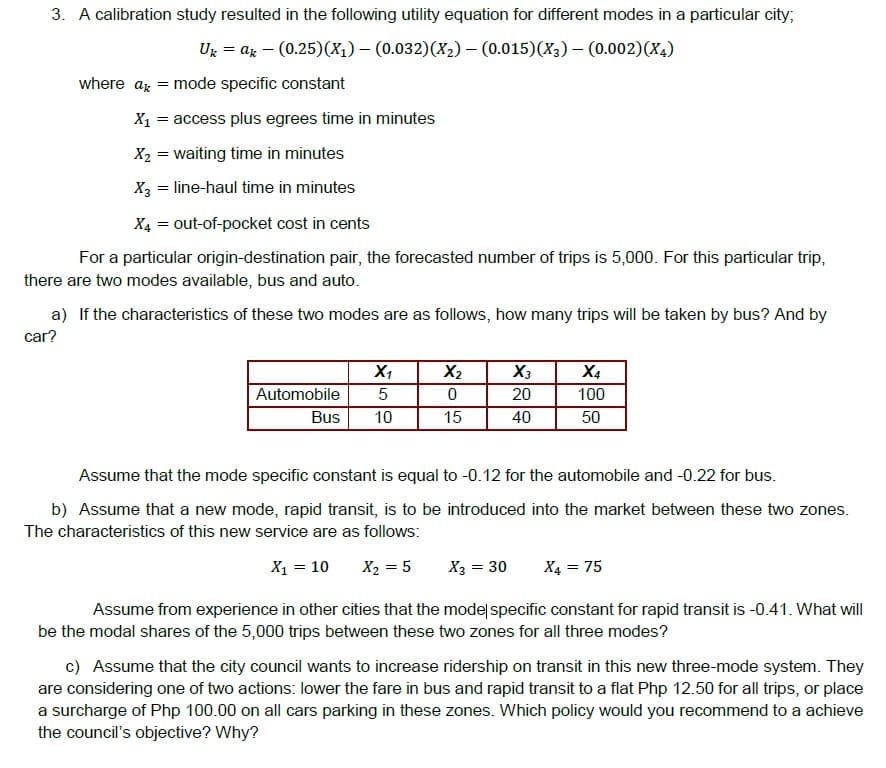3. A calibration study resulted in the following utility equation for different modes in a particular city; Ug = ax – (0.25)(X1) – (0.032)(X2) – (0.015)(X3)– (0.002)(X4) where ag = mode specific constant X1 = access plus egrees time in minutes X2 = waiting time in minutes X3 = line-haul time in minutes X4 = out-of-pocket cost in cents For a particular origin-destination pair, the forecasted number of trips is 5,000. For this particular trip, there are two modes available, bus and auto. a) If the characteristics of these two modes are as follows, how many trips will be taken by bus? And by car? X, X2 X3 Automobile Bus X4 100 50 20 10 15 40 Assume that the mode specific constant is equal to -0.12 for the automobile and -0.22 for bus. b) Assume that a new mode, rapid transit, is to be introduced into the market between these two zones. The characteristics of this new service are as follows: X1 = 10 X2 = 5 X3 = 30 X4 = 75 Assume from experience in other cities that the mode specific constant for rapid transit is -0.41. What will be the modal shares of the 5,000 trips between these two zones for all three modes? c) Assume that the city council wants to increase ridership on transit in this new three-mode system. They are considering one of two actions: lower the fare in bus and rapid transit to a flat Php 12.50 for all trips, or place a surcharge of Php 100.00 on all cars parking in these zones. Which policy would you recommend to a achieve the council's objective? Why?
A calibration study resulted in the following utility equation for different modes in a particular city;
??=??−(0.25)(?1)−(0.032)(?2)−(0.015)(?3)−(0.002)(?4)
where ??= mode specific constant
?1= access plus egrees time in minutes
?2= waiting time in minutes
?3= line-haul time in minutes
?4= out-of-pocket cost in cents
For a particular origin-destination pair, the forecasted number of trips is 5,000. For this particular trip, there are two modes available, bus and auto.
a) If the characteristics of these two modes are as follows, how many trips will be taken by bus? And by car?
Assume that the mode specific constant is equal to -0.12 for the automobile and -0.22 for bus.
b) Assume that a new mode, rapid transit, is to be introduced into the market between these two zones. The characteristics of this new service are as follows:
?1=10 ?2=5 ?3=30 ?4=75
Assume from experience in other cities that the mode specific constant for rapid transit is -0.41. What will
be the modal shares of the 5,000 trips between these two zones for all three modes?
c) Assume that the city council wants to increase ridership on transit in this new three-mode system. They
are considering one of two actions: lower the fare in bus and rapid transit to a flat Php 12.50 for all trips, or place
a surcharge of Php 100.00 on all cars parking in these zones. Which policy would you recommend to a achieve
the council’s objective? Why?

Trending now
This is a popular solution!
Step by step
Solved in 5 steps


